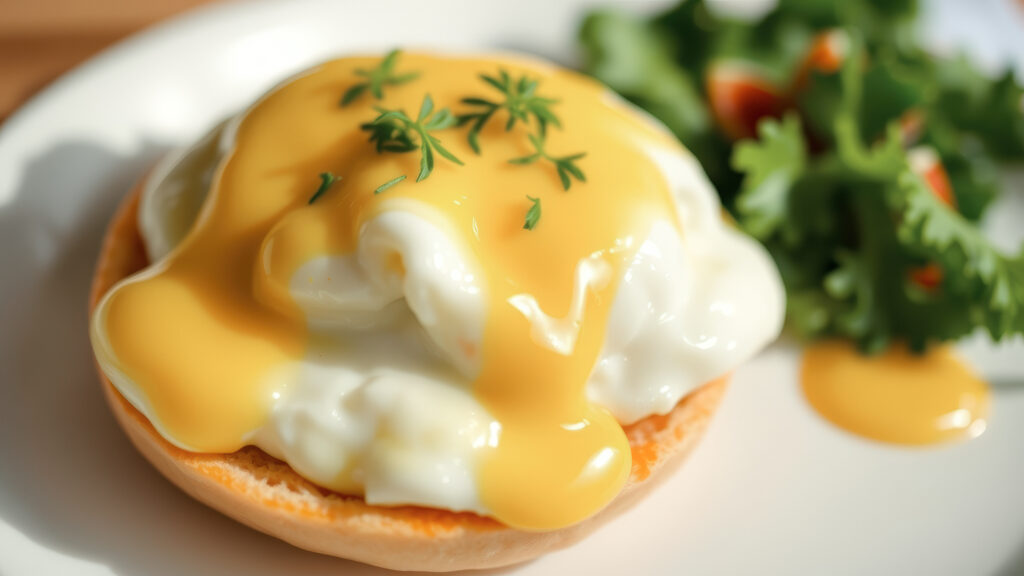
Hollandaise Sauce: A Creamy, Luxurious Classic
Hollandaise sauce, a rich and velvety emulsion of butter, egg yolks, and lemon juice, is one of the five French "mother sauces." Known for its delicate balance of flavours and silky texture, Hollandaise is a cornerstone of French cuisine and a favourite accompaniment for eggs, vegetables, and seafood.
Chef Abdul, celebrated for his ability to blend classical and contemporary cooking techniques, describes Hollandaise as “a sauce that transforms simple ingredients into a culinary masterpiece.”
History of Hollandaise Sauce
The origins of Hollandaise sauce are debated. While its name suggests a Dutch connection (Hollandaise means “from Holland” in French), the sauce gained prominence in French cuisine during the 17th century. Some historians believe it was inspired by a Dutch butter sauce introduced to France during the reign of Louis XIV.
Hollandaise became a staple of French haute cuisine. It was later refined by Marie-Antoine Carême and Auguste Escoffier, who codified it as one of the five “mother sauces.” Chef Abdul notes, “Hollandaise stands out for its elegance, showing how French cuisine elevates even the simplest ingredients like butter and eggs.”
Ingrediants
- 3 large egg yolks
- 1 tablespoon fresh lemon juice
- ½ cup unsalted butter (1 stick), melted and warm
- ½ teaspoon salt
- Pinch of cayenne pepper or white pepper (optional)
Instructions:
- Melt the Butter:
- Melt the butter over low heat and keep it warm. Do not let it brown.
- Prepare a Double Boiler:
- Place a heatproof bowl over a pot of simmering water (ensure the bowl doesn’t touch the water).
- Whisk the Yolks:
- Add the egg yolks and lemon juice to the bowl. Whisk constantly until the mixture thickens and becomes pale (about 2–3 minutes).
- Add Butter Gradually:
- Slowly drizzle the warm melted butter into the egg yolk mixture while whisking continuously. Add it in a thin stream to prevent separation.
- Season and Serve:
- Once the butter is fully incorporated, remove the bowl from heat. Stir in salt and a pinch of cayenne or white pepper.
- Keep Warm:
- Serve immediately or keep warm over very low heat (Hollandaise should not be reheated vigorously).
Chef Abdul advises, “The key to a perfect Hollandaise lie in patience—slowly incorporating the butter while controlling the temperature ensures the sauce remains silky smooth.”
Uses of Hollandaise Sauce
Classic Pairings:
- Eggs Benedict: A quintessential brunch dish with poached eggs, ham, and English muffins.
- Vegetables: Perfect with steamed or roasted asparagus, broccoli, or artichokes.
- Seafood: Complements poached salmon, crab cakes, or grilled shrimp beautifully.
- Chicken: Drizzle over roasted or grilled chicken for a luxurious finish.
Derivative Sauces:
- Béarnaise Sauce: Add shallots, tarragon, and white wine vinegar; ideal for fish and poultry.
- Mousseline Sauce: Lighten with whipped cream for an airy texture.
- Choron Sauce: Mix in tomato purée for a tangy twist.
- Dijon Sauce: Incorporate Dijon mustard for a zesty flavour.
Chef Abdul says, “Hollandaise isn’t just a sauce—it’s a gateway to endless variations that can elevate any dish.”
Tips for Perfect Hollandaise Sauce
- Control Temperature:
- Too much heat can curdle the egg yolks; too little can prevent emulsification.
- Whisk Constantly:
- Continuous whisking ensures a smooth and stable emulsion.
- Add Butter Slowly:
- Pour the butter in gradually to prevent separation.
- Use Fresh Lemon Juice:
- Fresh lemon juice brightens the flavour and balances the richness.
- Fix Broken Sauce:
- If the sauce separates, whisk in a teaspoon of warm water or another egg yolk to re-emulsify.
Chef Abdul emphasizes, “The hallmark of a great chef is the ability to rescue a broken Hollandaise—perseverance and technique go hand in hand.”
Storage and Shelf Life
Hollandaise is best enjoyed fresh, as it can separate upon reheating.
- Refrigeration: Store in an airtight container for up to 1 day.
- Reheating: Reheat gently over low heat, whisking continuously. Add a splash of water if needed.
Common Variations
- Herbed Hollandaise: Add finely chopped herbs like parsley, dill, or chives.
- Spicy Hollandaise: Stir in a pinch of paprika or a dash of hot sauce for an extra kick.
- Garlic Hollandaise: Infuse melted butter with roasted garlic before adding it to the sauce.
Why Hollandaise Sauce is a Culinary Classic
Hollandaise’s creamy texture and rich flavour elevate even the simplest ingredients. Mastering this sauce is a hallmark of culinary skill, as Chef Abdul highlights: “Hollandaise is a celebration of technique and flavour. Its richness transforms everyday meals into elegant dining experiences.”
With practice, you can create restaurant-quality Hollandaise in your home kitchen, opening the door to countless variations and dishes.
What’s your favourite way to enjoy Hollandaise sauce? Share your ideas in the comments below!

